
Mihingāwai x Mihingānuku Still can’t find the right words to express just how grateful I am to have been on this journey with you cuz. I’ve had these photos a couple days now mulling over it all and reminiscing 😆. What an incredible experience 🙌🏼 the best sitter in Aotearoa whānau, what a privilege to be a part of your haerenga! Kendall you absolute powerhouse! Legit the epitome of mana wāhine 👊🏼 I couldn’t have asked for the most trusting, patient and not awkward 👀 kaiwhiwhi in the whole world! Thank you and all your whānau for bringing the good vibes and surrounding us like a big hug 🥰 Moko Purua done by my talented cuzzy @toirukuwai, first time on the machine and absolutely smashed it me and chloea are so proud 🥹 and a big shout out to my tāne, bros and cousins, you know who you are, the real mvps, love you all 🥰 I will never be over this, the best week of moko 🥹 Love you









Ngāti Toa te whare o Waiōrangi - Toi Rangatira Exhibition.



Vianney Parata Kaiako Kōwhaiwhai - Puawānanga - hei tauira mō nag tauira o Toi Rangatira X Vianney Parata Te Ātiawa Ki Whakarongotai, Ngāti Toa, Ngāti Raukawa, Ngāi Tahu, Ngāpuhi, Ngāti Porou, Ngāti Kahungunu Pūhoro Acrylic on Rimu Pū means potential and horo means speed. Pühoro was traditionally used on the takere (hull) of Waka, signifying speed and swiftness, as was its meaning in ta Moko, used more specifically on the legs and thighs. It is used to represent the Moana or a body of water, journey, life, energy, movement, nga piki me nga heke, hononga ki to whakapapa. Pūhoro can be seen when the Waka glides through the water. X Vianney Parata Te Ātiawa Ki Whakarongotai, Ngāti Toa, Ngāti Raukawa, Ngāi Tahu, Ngāpuhi, Ngāti Porou, Ngāti Kahungunu Pūhoro - Mangopare Acrylic on Rimu Inspired by the Kōwhaiwhai in my whare at Whakarongotai, I have used the pattern on the tahuhu of Whakarongotai as a tauira to create this kōwhaiwhai. I have also used two elements of kōwhaiwhai, Pūhoro and Mangopare. I have used these to create a pattern based on the Puawānanga flower to create the chain of flowers and the points at the end of each pūhoro reflect the vines of the flower. X Vianney Parata Te Ātiawa Ki Whakarongotai, Ngāti Toa, Ngāti Raukawa, Ngāi Tahu, Ngāpuhi, Ngāti Porou, Ngāti Kahungunu Puawānanga Acrylic on Rimu Inspired by the kōwhaiwhai in my whare at Whakarongotai I have set out to create a new kōwhaiwhai. Puawānanga the clematis flower is the daughter of Rehua and Puanga and starts its blooming process in June through to december signifying the movement of Tamanui te Rā to Hine Raumati. The roots and vines were used as an afterbirth rongoā for our Wāhine and the sap taken from cut vines were used to heal wounds. Our nannies created Tīpare out of these for their debutante balls.

Kauia Moriarty Ngāti Toa Rangatira, Ngāti Koata, Ngāti Kahungunu Koiri Acrylic on Rimu Koiri represents the never ending potential of te Pō/te Ao. The Koiri is made up of pitau curling in on itself and is a visual representation of how plants grow, it denotes growth, movement, development, learning, reflection, to flourish, to embody something, to make something abundant, whakapapa and whānau. X Kauia Moriarty Ngāti Toa Rangatira, Ngāti Koata, Ngāti Kahungunu Ngā Tai o Raukawakawa Moana 1 Acrylic on Rimu $150 Inspired by the coastal settlements of Ngāti Toa Rangatira and the continual movement of waves coming into the shore and returning back to the depths of the moana. This pattern represents balance, new perspective, regeneration, fluidity, agility and movement. x Kauia Moriarty Ngāti Toa Rangatira, Ngāti Koata, Ngāti Kahungunu Ngā Tai o Raukawakawa Moana 2 Acrylic on Rimu $150 Inspired by the coastal settlements of Ngāti Toa Rangatira and the continual movement of waves coming into the shore and returning back to the depths of the moana. This pattern represents balance, new perspective, regeneration, fluidity, agility and movement. X Kauia Moriarty Ngāti Toa Rangatira, Ngāti Koata, Ngāti Kahungunu Whai Reo Whai Ora Acrylic on Rimu $150 A development from my previous panels Ngā Tai o Raukawa Moana, I was inspired by the coastal settlements of Ngāti Toa Rangatira and one of our katiaki - te whai; the stingray. I created this pattern to represent the agile movements of whai, and their ability to navigate both shallow and deep waters. The use and placement of the whai also speaks to the determination of our people to navigate challenges for the wellbeing of our iwi. X Kauia Moriarty Ngāti Toa Rangatira, Ngāti Koata, Ngāti Kahungunu Te Pūheke Acrylic On Kwila POA Inspired by the coastal settlements of Ngāti Toa Rangatira and the continual movement of waves coming into the shore and returning back to the depths of the moana. This panel is based on the concept developed in my smaller panels but uses the whakarare pattern as a different way to represent the movement of warer, new perspective, regeneration, fluidity and agility.
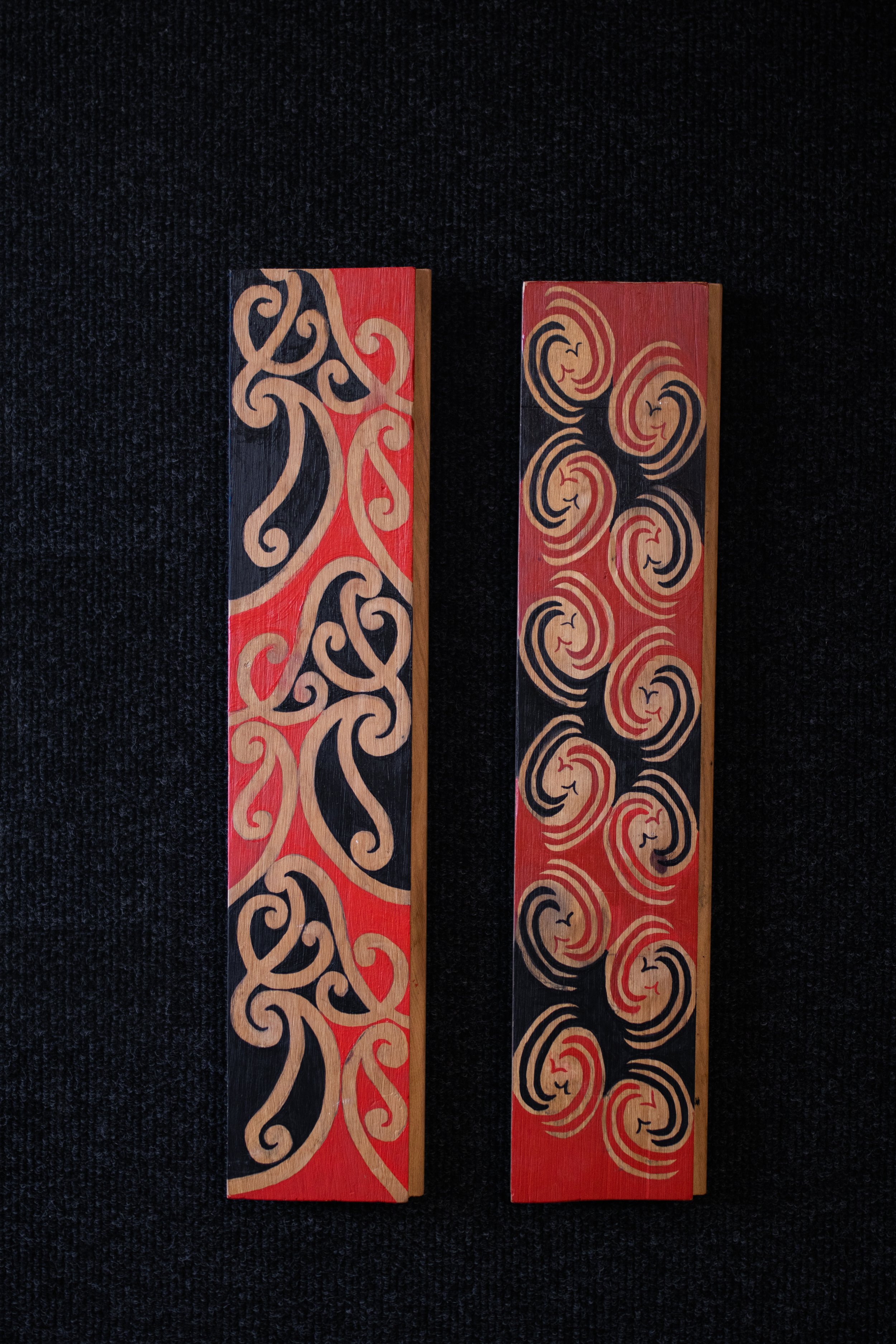
Elena Rei Ngāti Toa Rangatira, Ngāti Koata, Ngāruahine, Samoa Untitled Acrylic on Rimu This kōwhaiwhai is on the door of our whare tūpuna, Toa Rangatira. x Elena Rei Ngāti Toa Rangatira, Ngāti Koata, Ngāruahine, Samoa Untitled Acrylic on Rimu Drawing from the patterns within te taiao; above, below and around, this kōwhaiwhai represents ngā manu and the moana. The swirl reminiscent of the movements we see take shape in the sky and in the water, mirroring each other.

Tiana Solomon Ngāti Toa Rangatira, Te Ātiawa ki Whakarongotai, Ngāti Raukawa ki te Tonga Pūhoro Acrylic on Rimu Pū means potential and horo means speed. Pühoro was traditionally used on the takere (hull) of Waka, signifying speed and swiftness, as was its meaning in ta Moko, used more specifically on the legs and thighs. It is used to represent the Moana or a body of water, journey, life, energy, movement, nga piki me nga heke, hononga ki to whakapapa. Pūhoro can be seen when the Waka glides through the water. X Tiana Solomon Ngāti Toa Rangatira, Te Ātiawa ki Whakarongotai, Ngāti Raukawa ki te Tonga Pūhoro Manaia Acrylic on Rimu $100 The addition of Manaia is the kaitiaki supporting the pūhoro with the energy to enable strength and swiftness. X Tiana Solomon Ngāti Toa Rangatira, Te Ātiawa ki Whakarongotai, Ngāti Raukawa ki te Tonga Parāoa iti Acrylic on Rimu The Parāoa have been unveiled from the pūhoro to act as kaitaki on the great journey of life. x Tiana Solomon Ngāti Toa Rangatira, Te Ātiawa ki Whakarongotai, Ngāti Raukawa ki te Tonga Parāoa nui Acrylic On Kwila Ana tā te uaua parāoa. Behold the strength of the sperm whale. I am powerful.

Kohai Grace Ngāti Pōrou, Ngāti Toa, Te Ātiawa ki Whakarongotai me Ngāti Raukawa. Koiri 1 Acrylic on Rimu Koiri represents the never ending potential of te Pō/te Ao. The Koiri is made up of pitau curling in on itself and is a visual representation of how plants grow, it denotes growth, movement, development, learning, reflection, to flourish, to embody something, to make something abundant, whakapapa and whānau. X Kohai Grace Ngāti Pōrou, Ngāti Toa, Te Ātiawa ki Whakarongotai me Ngāti Raukawa. Koiri 2 Acrylic on Rimu Koiri represents the never ending potential of te Pō/te Ao. The Koiri is made up of pitau curling in on itself and is a visual representation of how plants grow, it denotes growth, movement, development, learning, reflection, to flourish, to embody something, to make something abundant, whakapapa and whānau. X Kohai Grace Ngāti Pōrou, Ngāti Toa, Te Ātiawa ki Whakarongotai me Ngāti Raukawa. Kōwhai Ngutu Kākā Acrylic on Rimu Kākā represent the pursuit of knowledge 'Te Manu e kai ana te miro, nona te ngahere, te manu e kai te matauranga, nona te ao' the forest belongs to the bird who feasts on the miro berry, the world belongs to the bird who feasts on knowledge.

Te Aomania Grace-Paul Ngāti Toa Rangatira, Ngāti Porou, Te Arawa, Kai Tahu Te Tau Tuatahi: Kaokao Kaho (pine half rounds), kakahō (cane), acrylic paint, kiekie, pīngao In te ao Māori, the kaokao pattern represents the comforts of a mother's arms. The first panel I was gifted was a kaokao tukutuku from my mum, and so it felt fitting that I created this panel for my daughter for her first year of life. x Te Aomania Grace-Paul Ngāti Toa Rangatira, Ngāti Porou, Te Arawa, Kai Tahu Te Tau Tuatahi: Pātikitiki kaho (pine half rounds), kakahō (cane), acrylic paint, kiekie, pīngao The traditional representation of the pātikitiki pattern presents abundance or plenty. Pātikitiki is my favourite tukutuku design. Having this design in the series was fitting to demonstrate the abundance I have received during my first year of being a Māmā, and the first year of my daughter’s life. X Te Aomania Grace-Paul Ngāti Toa Rangatira, Ngāti Porou, Te Arawa, Kai Tahu Te Tau Tuatahi: Niho Taniwha & Purapurawhetū Kaho (pine half rounds), kakahō (cane), acrylic paint, kiekie, pīngao Niho Taniwha and Purapurawhetū has been used to create this tukutuku. The niho taniwha pattern represents imagination and creativity and is placed in the middle of the panel , with the purapurawhetū on the outside representing the stars in the sky, being the people in my daughter’s life that nurture and encourages her imagination, and allowing it to run wild! X Te Aomania Grace-Paul Ngāti Toa Rangatira, Ngāti Porou, Te Arawa, Kai Tahu Te Tau Tuatahi: Roimata Toroa Kaho (pine half rounds), kakahō (cane), acrylic paint, kiekie, pīngao The tukutuku pattern ‘Roimata Toroa’ speaks about the importance of upholding the traditions and tikanga of old, such as the practice of reciting karakia and incantations to thus ensure the health, safety and protection of iwi and natural resources. Roimata Toroa in my ‘Te Tau Tuatahi’ series represents the struggles of being a parent, the emotional, physical and spiritual toll that the sleepless nights, sickness, and separation anxiety can cause. The pingao used on the tukutuku represents the happy tears I’ve experienced, like the tears when my baby was first placed on my chest at birth, and the tears of unconditional love and happiness. The tears of the toroa (roimata toroa) in this panel represents my own tears - both good and bad. X Maikara Thorpe Ngāti Toa Rangatira/Ngāti Mutunga/Ngāti Tama Patu Rimu, muka, feathers He taonga whai atu te mātauranga. Ka pū te ruha, ka hao te rangatahi. X Kukutai Thorpe Ngāti Toa Rangatira/Te Āti Awa Patu Rimu Working on a patu was the next step in our whakairo class. This one was shaped out and gifted to me to carve

Moana Solomon Ngāti Toa Rangatira, Te Ātiawa ki Whakarongotai, Ngāti Raukawa, Ngāti Koata, Ngāti Rārua, Ngāti Tama, Ngāi Tahu Ngutukākā Kaperua Acrylic on Rimu Kākā represent the pursuit of knowledge 'Te Manu e kai ana te miro, nona te ngahere, te manu e kai te matauranga, nona te ao' the forest belongs to the bird who feasts on the miro berry, the world belongs to the bird who feasts on knowledge" X Moana Solomon Ngāti Toa Rangatira, Te Ātiawa ki Whakarongotai, Ngāti Raukawa, Ngāti Koata, Ngāti Rārua, Ngāti Tama, Ngāi Tahu Miro Pouhine Acrylic on Rimu POA Pouhine (acknowledges and celebrates tūpuna wāhine - ascending steps in pursuit of knowledge and understanding) and Miro (representing raranga, he taonga tuku iho) X Moana Solomon Ngāti Toa Rangatira, Te Ātiawa ki Whakarongotai, Ngāti Raukawa, Ngāti Koata, Ngāti Rārua, Ngāti Tama, Ngāi Tahu Tuna heke tuatahi Acrylic on Rimu POA Tuna life cycle includes changing physical appearance once they reach a certain maturity, in preparation for travelling the ocean to breed the next generation. They are known for adaptation, migration, resilience and perseverance - pērā i te heke mai raro o te iwi nei.

Keanyn Arthur Ngāti Toa Rangatira, Waikato-Tainui, Ngāti Maniapoto, Rangitāne o Wairau Te Ahi Whitawhita o Ngāti Toa Acrylic On Kwila This design was inspired by one of the kōwhaiwhai panels in our wharenui, and a well-known symbol within our iwi - Ahikā. Ahikā: Symbolic of two cupped hands holding a flame within, keeping it safe and protected and nurtured - Keeping our home-fires burning. Ngāti Toa/Iwi: Symbolic of te iwi o Ngāti Toa Rangatira for me personally, however, this design is relevant to any iwi. This kaupapa is not unique as we all as tangata Māori work for the betterment of our community and people. It represents the progress of iwi, nurturing and raising each other up, being guided by our tūpuna, and paving the way for future generations to excel. Building strength upon the shoulders of those who have come before us.






He rau ringa e oti ai: Many hands make light work. This mural is dedicated to my tūpuna — Wī Te Kākākura Parata and Unaiki Pukehi who founded Waikanae — as well as their uri, whānau and hāpori. The hands in this work represent the whakataukī above and the spirit of kotahitanga that built Waikanae from its first foundations to now. It is also an acknowledgment of Te Kākākura and Unaiki who dedicated their lives to building a community that held connection at the centre of everything — to whenua, home and each other. Bringing people together was their aspiration and their legacy. The designs woven throughout the work reference the flax-processing, timber-felling and whaling industries that our people worked in over the decades. The manu references the post office that stood as the heartbeat of the town for so long, as well as the abundance of bird life in Waikanae. The red outlines refers to the awa that become oceans and oceans that become awa. At the top, those three notches make up two niho taniwha patterns that reference our taniwha, Te Kopaeara who dwells in the Waikanae river and travels from Kapakapanui to Kapiti guarding our sacred waters. Tēnei tō uri e whakaaronui ana ki a kōrua me ōu ringa raupā ❤️




Kōwhaiwhai workshop at Te Papa for Te wiki o te Reo Māori focussing on our visual language.





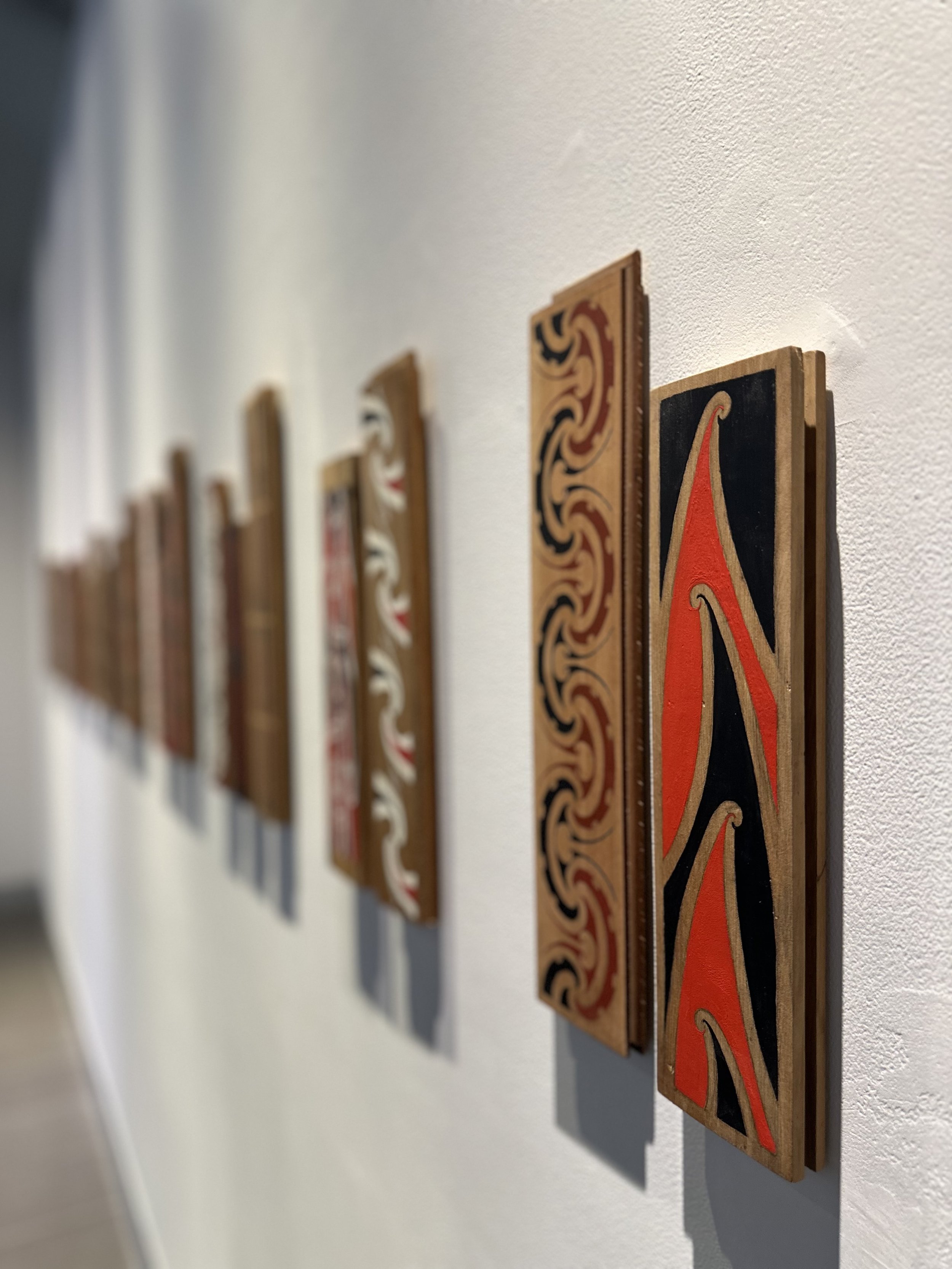
Toi Rangatira Kōwhaiwhai Tauira 2023 M U T U N G A K O R E Mutunga Kore is an exploration of visual language born from the traditional practice of kōwhaiwhai painting. Here, it is used to share stories and narratives from the lens of Vianney Parata and Kauia Moriarty about their whakapapa as uri of Ngāti Toa Rangatira. Mutunga Kore aims to intertwine concepts of history, toi Māori and collective identity through visual storytelling. This exhibition explores cultural narratives and whakapapa as a way of binding people to the past, present, and future. Mutunga Kore can be defined as ‘infinite or endless potential’. This exhibition is an homage to the abundance and endless potential of kōwhaiwhai and toi Māori as a visual language for our people. An important part of bringing together this exhibition has been the tuakana / teina approach. Vianney is currently mentoring Kauia in her development as an artist, and this project has enabled a space and context for both to draw deeper on their interpersonal connections, creative development and growth through both toi and whakapapa. Vianney Parata | @vianneybrotoi Kauia Moriarty | @terangikauia Ngāti Toa Rangatira, Te Ātiawa ki Whakarongotai, Ngāti Toa Rangatira, Ngāti Koata, Ngāti Raukawa, Ngā Puhi, Ngāti Porou, Ngāti Kahungunu Ngāti Kahungunu T E P Ū O H O K A T E N E & T A N A S A L Z M A N N Te Pūoho is known for his contribution to the kōwhaiwhai adorning the heke at Takapūwāhia marae. The Ahikā kōwhaiwhai design was designed by Te Pūoho and is an example of the high quality and intricate style of his mahi toi. Tana Salzmann is known for his innovative and contemporary contributions to the visual language of Ngāti Toa Rangatira, and as an artist he was continuously creating and innovating through toi. Te Pūoho’s style and respect for traditional techniques have taught us the importance of patience, having an eye for detail and honouring traditional patterns & motifs in our approaches to design and painting. Tana’s dedication to evolving our visual language has encouraged us to explore and expand the boundaries of traditional design whilst pushing the limits of our own artistic expression. As ringatoi, we aspire to apply the same level of care, precision and innovation that Te Pūoho and Tana demonstrated. Inspired by them both, we have developed a series of contemporary designs that incorporate traditional concepts, reimagined in new contexts. K E R E H I W A I A R I K I G R A C E & B R I A N G U N S O N Kerehi Waiariki Grace and Brian Gunson introduced contemporary kōwhaiwhai, with a deep foundation of tikanga Māori, into Hongoeka Marae. These kōwhaiwhai explore the use of colour and innovative designs which adorn the wharetūpuna, Te Heke Mai Raro. Their work blended contemporary elements with traditional designs and has shown us the potential of innovation within traditional cultural contexts and settings. Their approach has given us the confidence to experiment with new ideas while respecting the essence of traditional aesthetics. In Mutunga Kore we explored the use of modern colour palettes and digital design techniques with traditional motifs. This fusion was directly inspired by the innovative approaches of Waiariki Grace and Brian Gunson, reflecting a harmonious blend of old and new. Their innovation has encouraged us to expand our thinking in designing these new kōwhaiwhai.
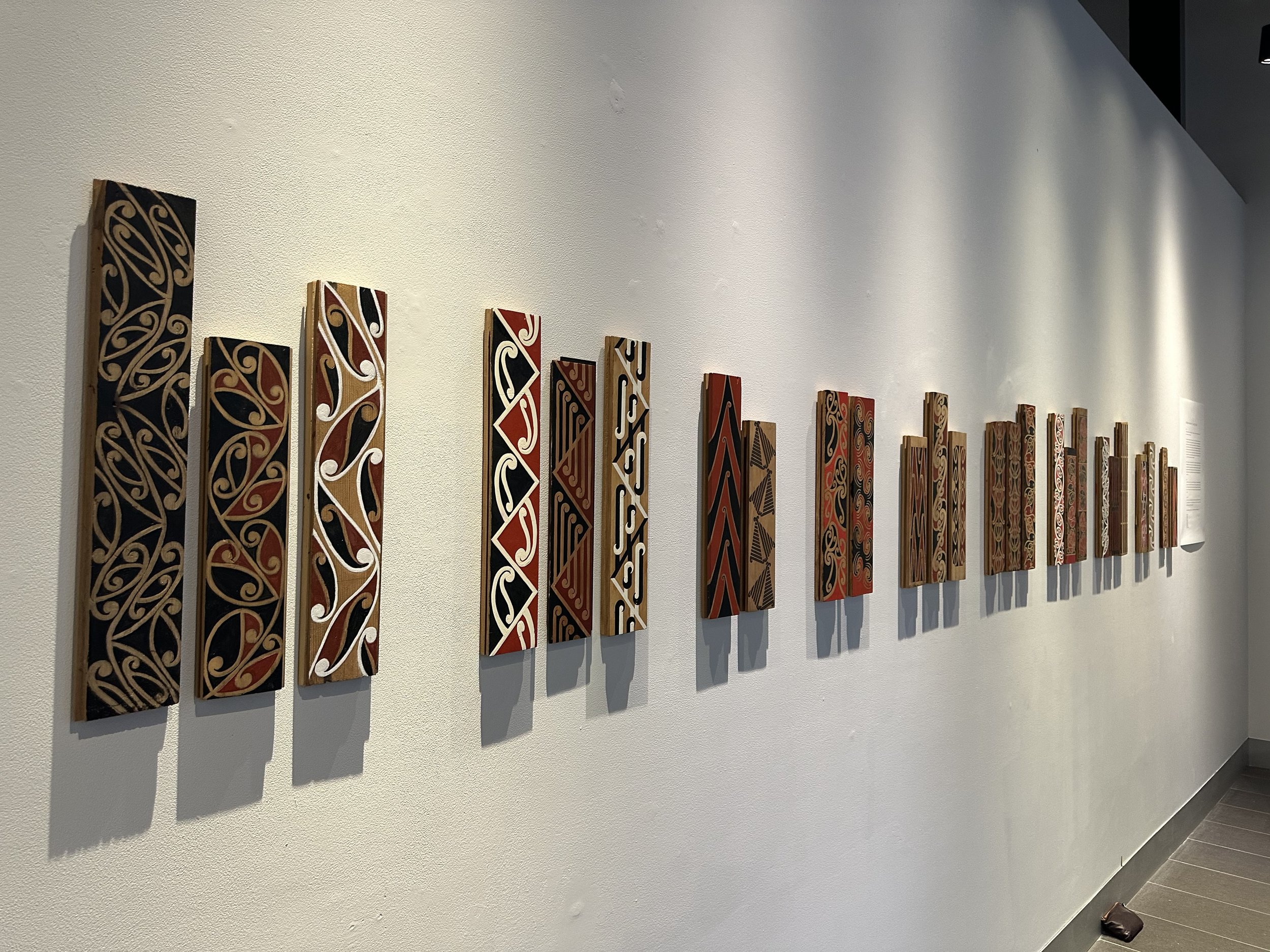
Toi Rangatira Kōwhaiwhai Tauira 2023 K Ō W H A I W H A I C L A S S 2 0 2 3 Vianney In 2023 I started teaching a kōwhaiwhai painting class for Te Rūnanga o Toa Rangatira. This really started my journey in re-connecting to my Ngāti Toa whakapapa. The idea of creating new kōwhaiwhai for Ngāti Toa began in this class and was inspired by the fact that in Takapūwāhia, only one of the kōwhaiwhai panels in the wharenui was designed by someone from Ngāti Toa - this was Te Pūoho Katene and the kōwhaiwhai is called Ahikā. The remaining kōwhaiwhai were inspired by Ngāti Porou kōwhaiwhai, the Williams collection and Te Hau ki Tūranga marae now located in Te Papa. It's important to note that when Takapūwāhia Marae was being reconstructed, Te Pūoho decided to use screen printing techniques to ensure that the standard of kōwhaiwhai would match that of the whakairo and tukutuku. This enabled the toi to exist harmoniously, despite the challenges our iwi faced in finding painting practitioners in time for the work to be completed. This was a challenge faced by most iwi throughout the motu, during a time where our toi practices were being revitalised as a result of colonisation. Within our akomanga, tauira are encouraged to explore this part of our whakapapa toi. They quickly picked up traditional kōwhaiwhai patterns and techniques and were drawn to ones that most resonated with them. They went from finding particular patterns really difficult to draw, to being able to sketch them comfortably and with ease. Spending time on these foundational techniques really helped the tauira to envision what a new pattern could look like - watching them explore this was really beautiful to witness. Without this class and experience with my beautiful whanaunga I would not have been creatively prepared for this exhibition. Kauia I was lucky enough to be one of the tauira in this kōwhaiwhai class. Being in this environment alongside whanaunga was truly life changing. It was here I was able to grow, create toi, and share in a creative journey together with cousins, aunties and uncles. This experience ignited a type of reconnection to whakapapa I had not yet experienced - suddenly I was starting to see the kōrero of our history through the lens of toi. Without this experience, I most certainly would not have landed here, where I am today. From us both With that in mind, we want to acknowledge our whanaunga from last year’s class. Together, we got to develop our toi and create new kōwhaiwhai reflective of our surrounding taiao across the rohe of Ngāti Toa, while sharing stories and building deeper connections with each other. Mei kore ake koutou! We are incredibly grateful to be able to share some of the kōwhaiwhai from last year by the following ringatoi: Kohai Grace Jolie Gunson Nui Stretch Elena Rei Vianney Parata Kauia Moriarty Keanyn Arthur Te Ata Arthur Tiana Solomon Hermann Salzmann

T A H U T A H U A H I K Ō W H A I W H A I B Y V I A N N E Y P A R A T A acrylic on wood This design was inspired by Te Heke Tahutahu Ahi - the first migration of Ngāti Toa after being under siege for months at Kāwhia. As a result of much negotiation, Te Rauparaha was able to leave the area and take his people with him. Near the Mōkau river, they soon heard that Ngāti Maniapoto were trying to capture them. Te Rauparaha, accompanied by a small ope, namely wāhine, decided to dress them in kākahu and have them stand by multiple fires to create the illusion from afar that there were more of them. The white depicts the fingernails of Mahuika and represents the whakapapa of fire. The black represents the darkness of the heke and the red and yellow represents the burning embers that kept our tūpuna alive that night. This pattern represents self determination, resilience and innovation. I N S T A L L A T I O N Cup, horu, ngaarahu and candle/fairy lights
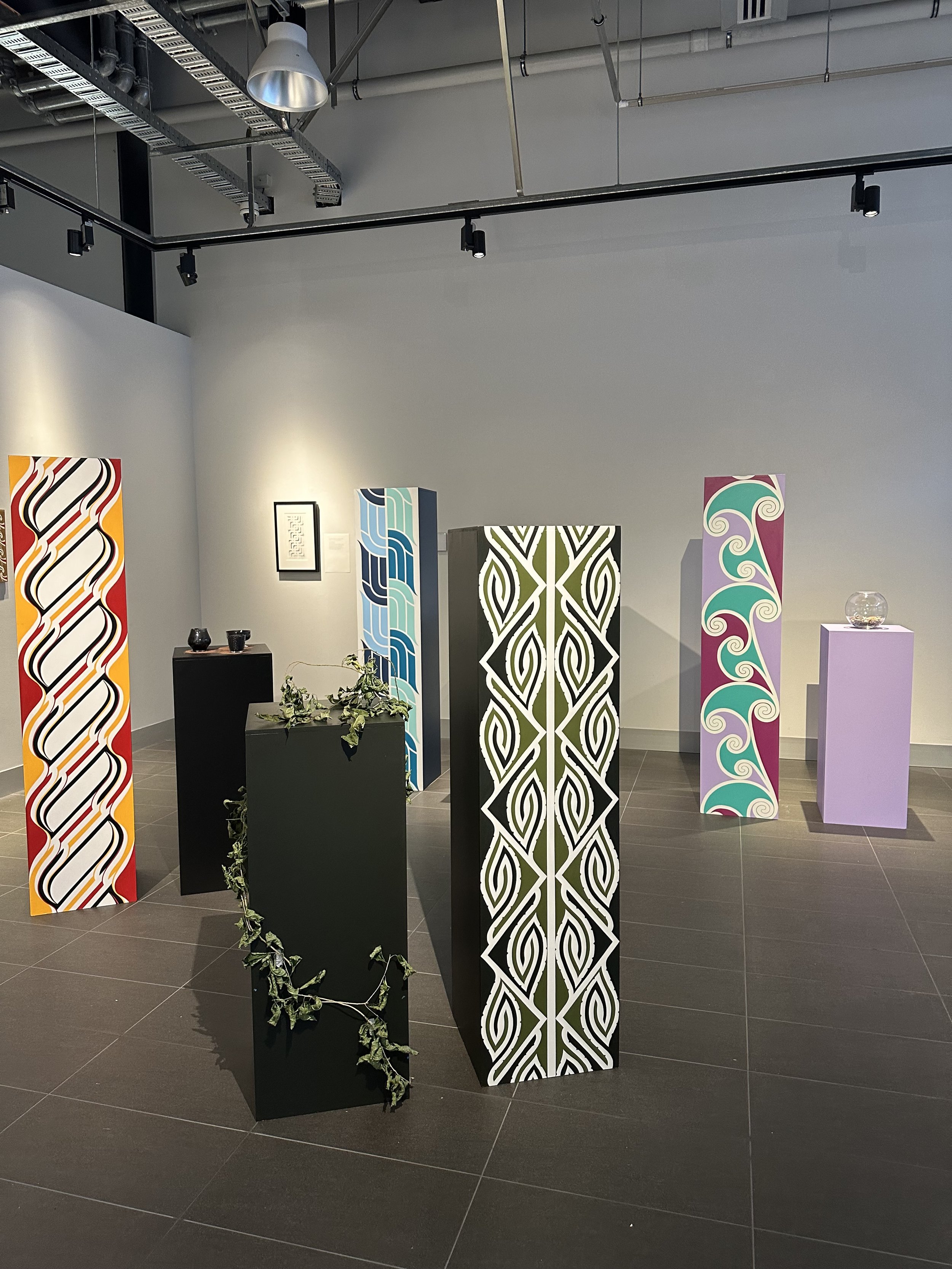
T Ā T A R Ā M O A K Ō W H A I W H A I B Y V I A N N E Y P A R A T A acrylic on wood Inspired by Te Heke Tātarāmoa. After the first migration found shelter in Taranaki with their Ngāti Mutunga whanaunga, Ngāti Toa found rest, and gathered kai and materials for the journey further south. The migration was difficult - there were pakanga that followed, the terrain of the whenua changed along the way, the temperature dropped further south and many loved ones could not carry on and make the full journey. Ngāti Toa eventually reached the Kāpiti region. This second heke was called Te Heke Tātarāmoa indicating the difficulties they encountered along the way. This pattern depicts the tātarāmoa leaf and its jagged edges. The jagged edges were inspired by niho taniwha and its association to protection. The mirrored design represents the skies, mountains, rivers, oceans and land symbolising the difficult journey of Te Heke Tātarāmoa. This Kōwhaiwhai represents perseverance, resilience, courage and determination. I N S T A L L A T I O N Tātarāmoa plant

M A N G O T A R I N G A T A H I K Ō W H A I W H A I B Y K A U I A M O R I A R T Y acrylic on wood This pattern was inspired by the whakatauki “mango taringa tahi” and its reference to the people of Ngāti Mango. This was an old name for the iwi in Kāwhia before we migrated further south to Te Upoko o te Ika and Te Tau Ihu. The descendants ultimately became three different iwi - Ngāti Toa Rangatira, Ngāti Koata, Ngāti Rārua. The whakatauki can refer to us “only needing to be told once” and also the ability to move as one. This design uses the rauru pattern to create mangopare formations, mimicking the shape of shark’s head. There are three mango unified together as one. The use of the rauru to depict the mangopare represents fluidity and movement. Overall, the mangopare represents the determination, resilience, courage and perseverance of our people. I N S T A L L A T I O N Niho mako, stones from Tapu te Ranga, glass bowl
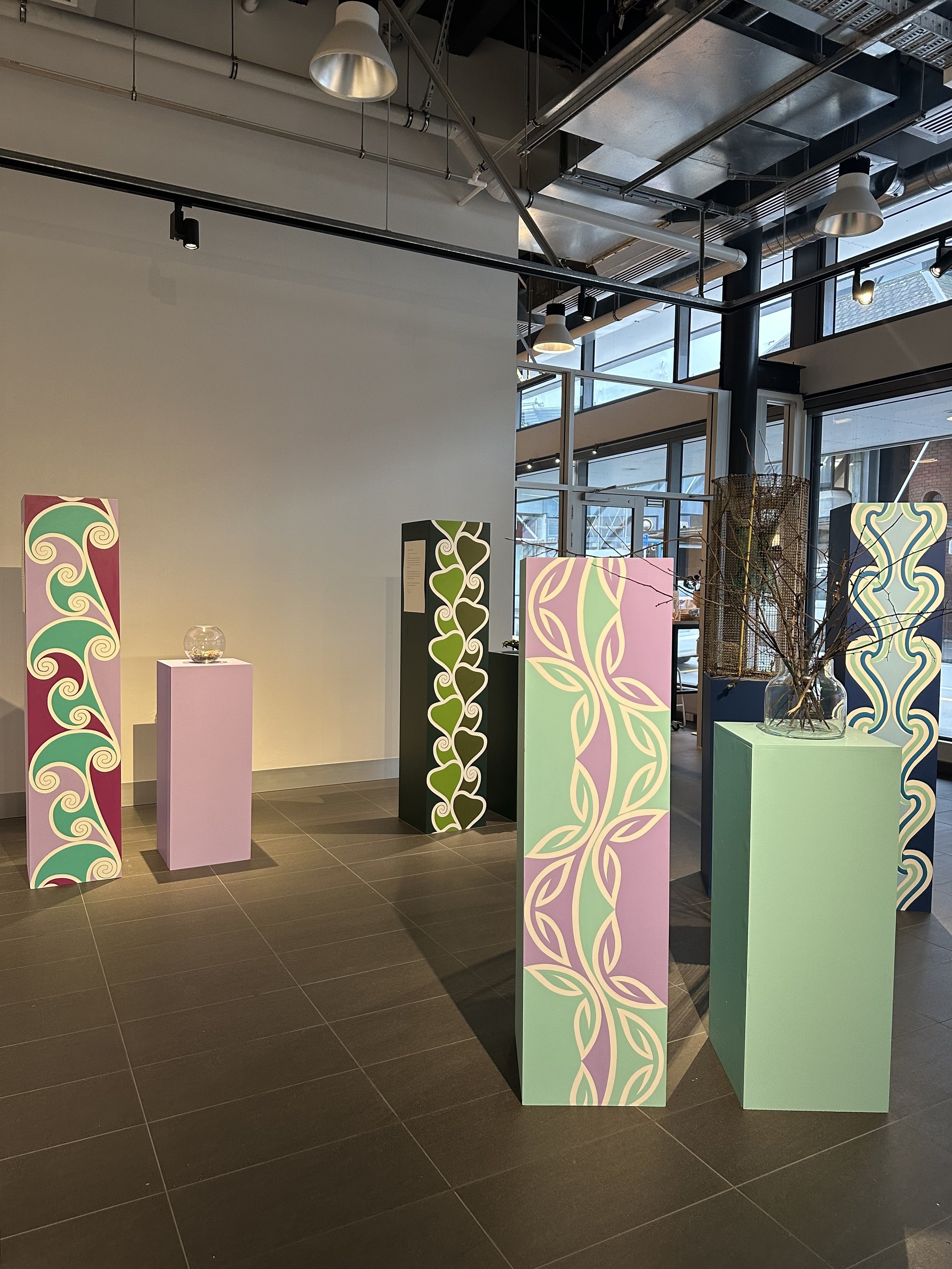
P U A W Ā N A N G A K Ō W H A I W H A I B Y V I A N N E Y P A R A T A acrylic on wood This pattern was inspired by my whare at Whakarongotai and the close links between Te Ātiawa ki Whakarongotai and Ngāti Toa. Puawānanga, the clematis flower, is the daughter of Rehua and Puanga. It blooms from June through to November. It signifies the movement of Tamanui te Rā from Hine Takurua to Hine Raumati. The roots and vines were used as a rongoā for our Wāhine for afterbirth and the sap taken from cut vines were used to heal wounds. The manawa line depicts the way this plant grows and represents the rongoā found in the roots. The flower shape has six points and references the six petals of the flower, the sharp edges in the pattern represents the plant's vine like āhua. This pattern represents growth, adaptability and oranga. I N S T A L L A T I O N Puawānanga
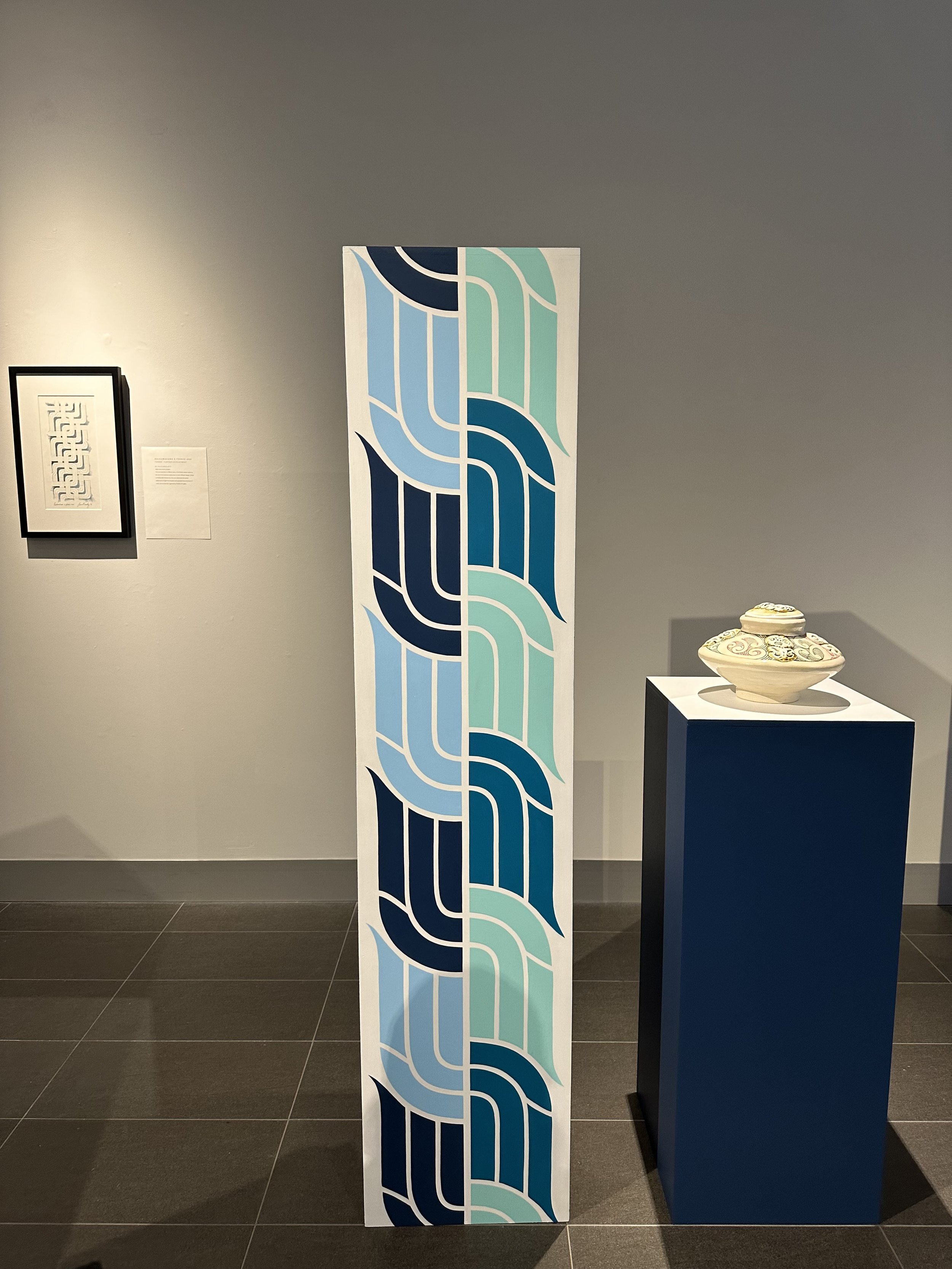
P Ū H E K E M A I | P Ū H E K E A T U K Ō W H A I W H A I B Y K A U I A M O R I A R T Y acrylic on wood Pūheke Mai | Pūheke Atu is inspired by the coastal settlements of Ngāti Toa Rangatira. It speaks to the agility and adaptibility of our people. This pattern was first developed while living on the south coast at Taputeranga. I was inspired by the moana on my doorstep and taken by the continual movement of waves coming into the shore and returning back to the depths of the moana. It ignited thoughts of perspective, regeneration and the idea that very rarely are things constant, but rather forever moving, changing, and developing. This particular kōwhaiwhai evolved from a range of pūheke designs I created back in 2023, all of which took inspiration from the whakarare pattern more commonly seen in whakairo (carving) in the marae. The adaption of the whakarare pattern is used as a different way to represent the movement of water, new perspective, regeneration, fluidity and agility. I N S T A L L A T I O N The uku (pottery) was made by my Uncle Johny Moriarty and gifted to my Dad - I have always loved this piece. It is included alongside Pūheke Mai | Pūheke Atu to represent the important role my whānau play in inspiring my toi journey. It is an acknowledgement of the artists and creatives in our whānau who have inspired me to push myself within te ao Toi.
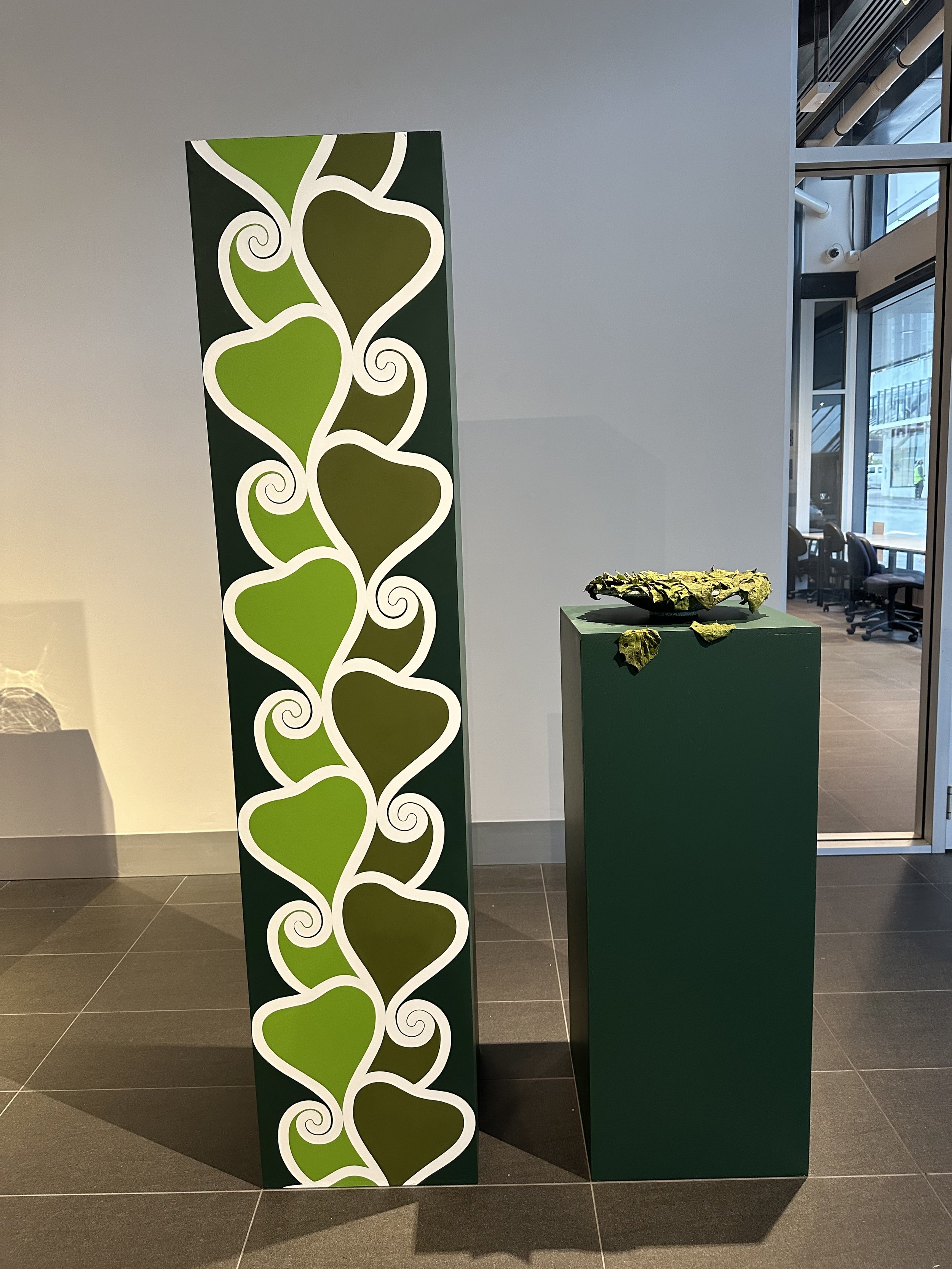
R A U K A W A K A W A K Ō W H A I W H A I B Y V I A N N E Y P A R A T A acrylic on wood This pattern was inspired by rau kawakawa (kawakawa leaf) and tākawa (fruit of the kawakawa). Kawakawa is plentiful in the rohe of Ngāti Toa and the tākawa, when turned orange, is edible. The tākawa can be seen in the rauru shape curling into the rau. This represents its natural position of growth. Te Moana o Raukawakawa is a significant body of water to our iwi - all along the coasts where Ngāti Toa have settled. The manawa line down the middle of the pattern represents the flow of water across the strait between Te Upoko o te Ika and Te Tau Ihu. The repeating formation of the unfurling kawakawa leaf represents the abundance, movement, a journey and protection. I N S T A L L A T I O N Kawakawa, oko, water
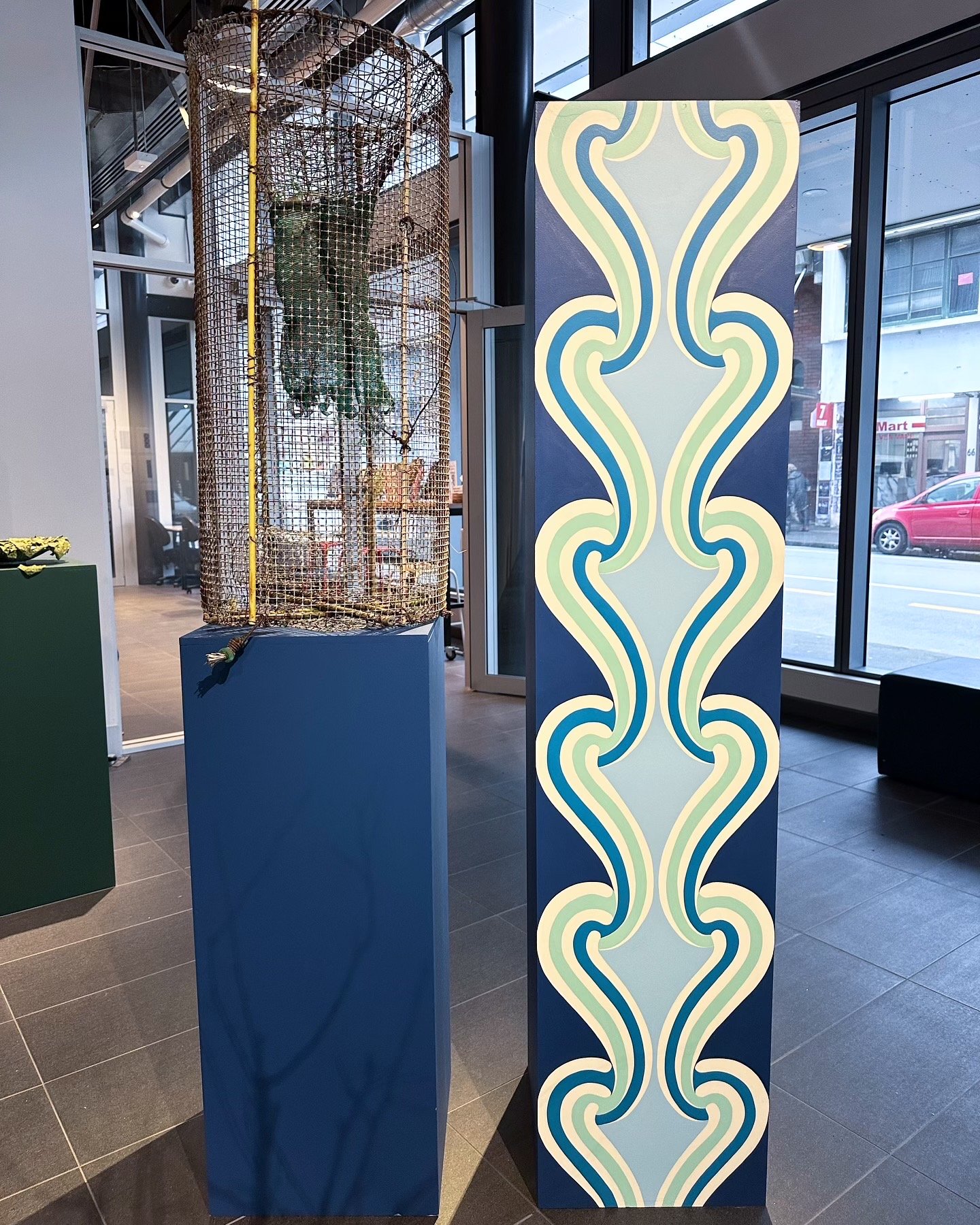
R A T A P U K Ō W H A I W H A I B Y V I A N N E Y P A R A T A acrylic on wood This pattern is a combination of Tuna and Whai, where the white spaces represent the Tuna and the inner detail signify the Whai. The repeated design creates a subtle ripple effect symbolising the waters they navigate. This design is named after uncle Ratapu Nelson Leigh Solomon, a prominent figure within his iwi known for his generosity, mātauranga, quick wit and passion for the Toa rugby and league clubs. Uncle was a skilled eeler and loved spending time catching eels at his favourite spots. He was very careful about where and when he gathered and cultivated kai, as he knew the importance of knowing the whakapapa of what he was consuming. He maintained strong relationships with his people - through growing up in Takapūwāhia, countless raumati in Te Tau Ihu, his connection to his Whakarongotai whānau, and playing a significant role within his iwi of Ngāti Toa Rangatira. This pattern symbolises abundance, knowledge, navigation, communication and the importance of whakapapa. I N S T A L L A T I O N Hīnaki - belonged to and used by Uncle Nelson
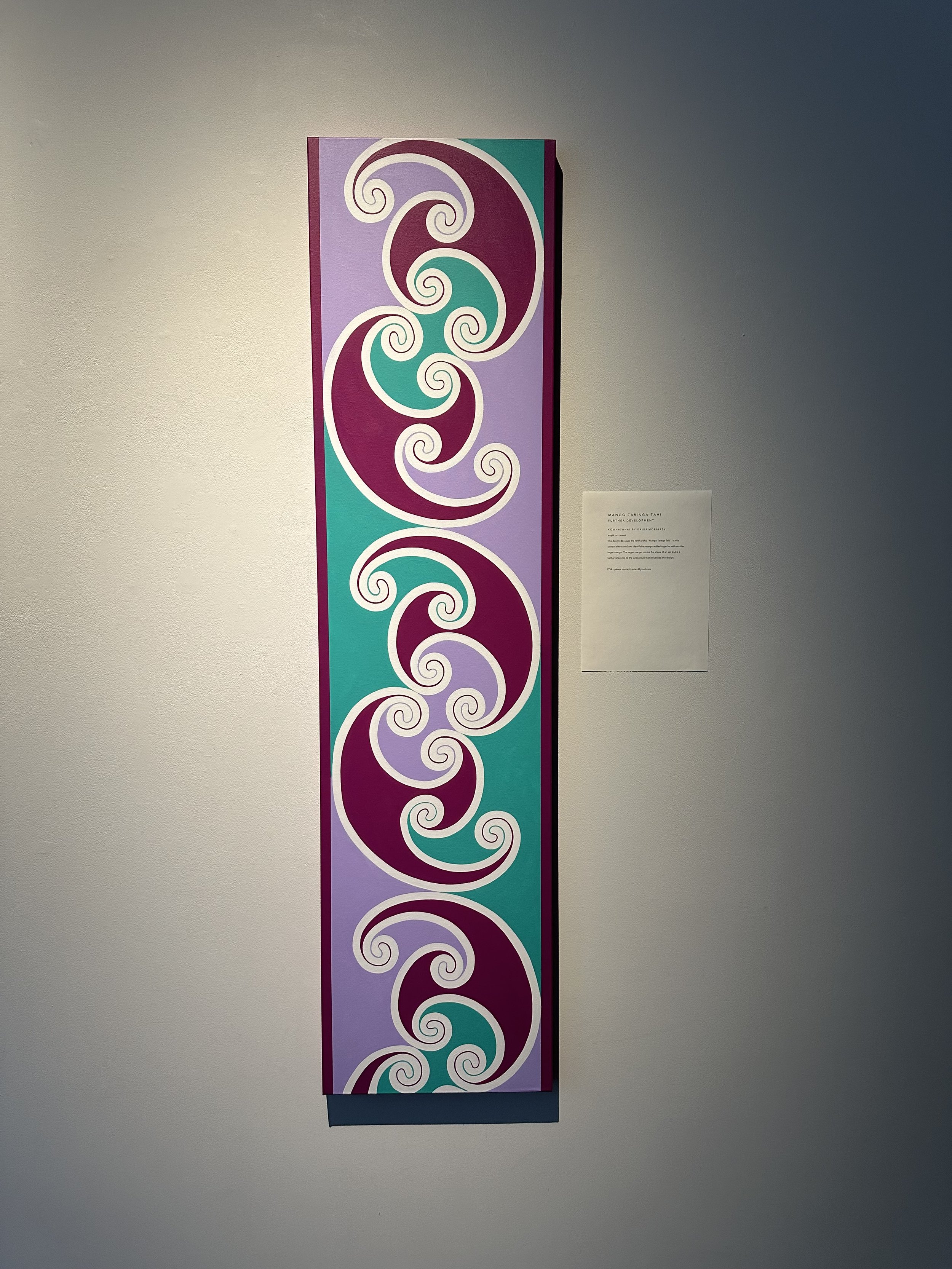
M A N G O T A R I N G A T A H I F U R T H E R D E V E L O P M E N T K Ō W H A I W H A I B Y K A U I A M O R I A R T Y acrylic on canvas This design develops the kōwhaiwhai “Mango Taringa Tahi”. In this pattern there are three identifiable mango unified together with another larger mango. The larger mango mimics the shape of an ear and is a further reference to the whakatauki that influenced this design.
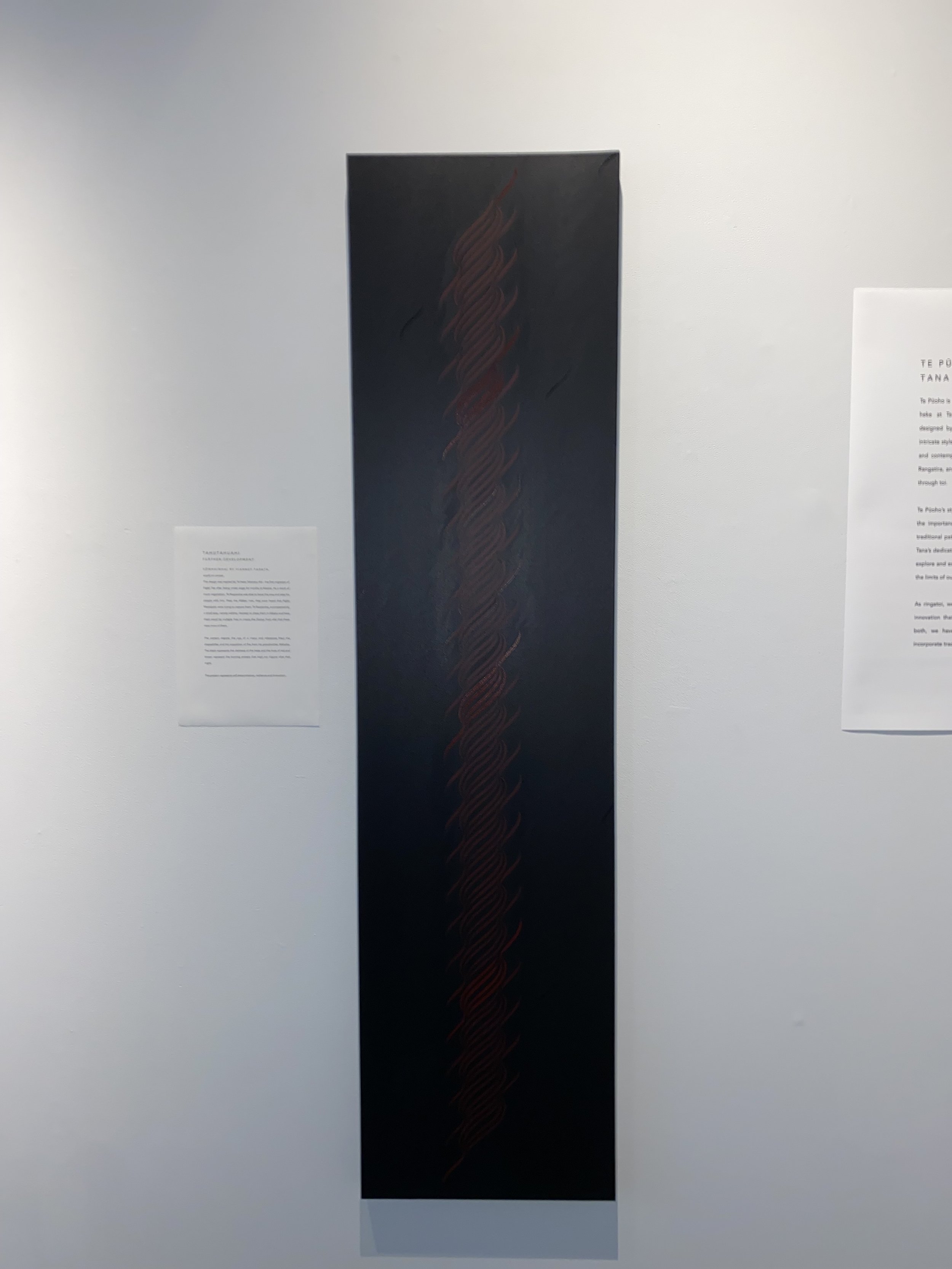
T A H U T A H U A H I F U R T H E R D E V E L O P M E N T K Ō W H A I W H A I B Y V I A N N E Y P A R A T A acrylic on canvas This design was inspired by Te Heke Tahutahu Ahi - the first migration of Ngāti Toa after being under siege for months at Kāwhia. As a result of much negotiation, Te Rauparaha was able to leave the area and take his people with him. Near the Mōkau river, they soon heard that Ngāti Maniapoto were trying to capture them. Te Rauparaha, accompanied by a small ope, namely wāhine, decided to dress them in kākahu and have them stand by multiple fires to create the illusion from afar that there were more of them. The pattern depicts the eye of a manu and references Maui the shapeshifter and his acquisition of fire from his grandmother Mahuika. The black represents the darkness of the heke and the hues of red and brown represent the burning embers that kept our tūpuna alive that night. This pattern represents self determination, resilience and innovation.

Vianney doing Tahiti Moko Kauae surrounded by our best friends Te Rina, Rahera and Te Oraiti.

Turkana - Teina - Sian and Vianney.



Tahiti Akavi Ngāti Tama, Taranaki. Kuki Airani.

Āku hoa pūmau nō te Kōhanga reo o Titahi Bay.
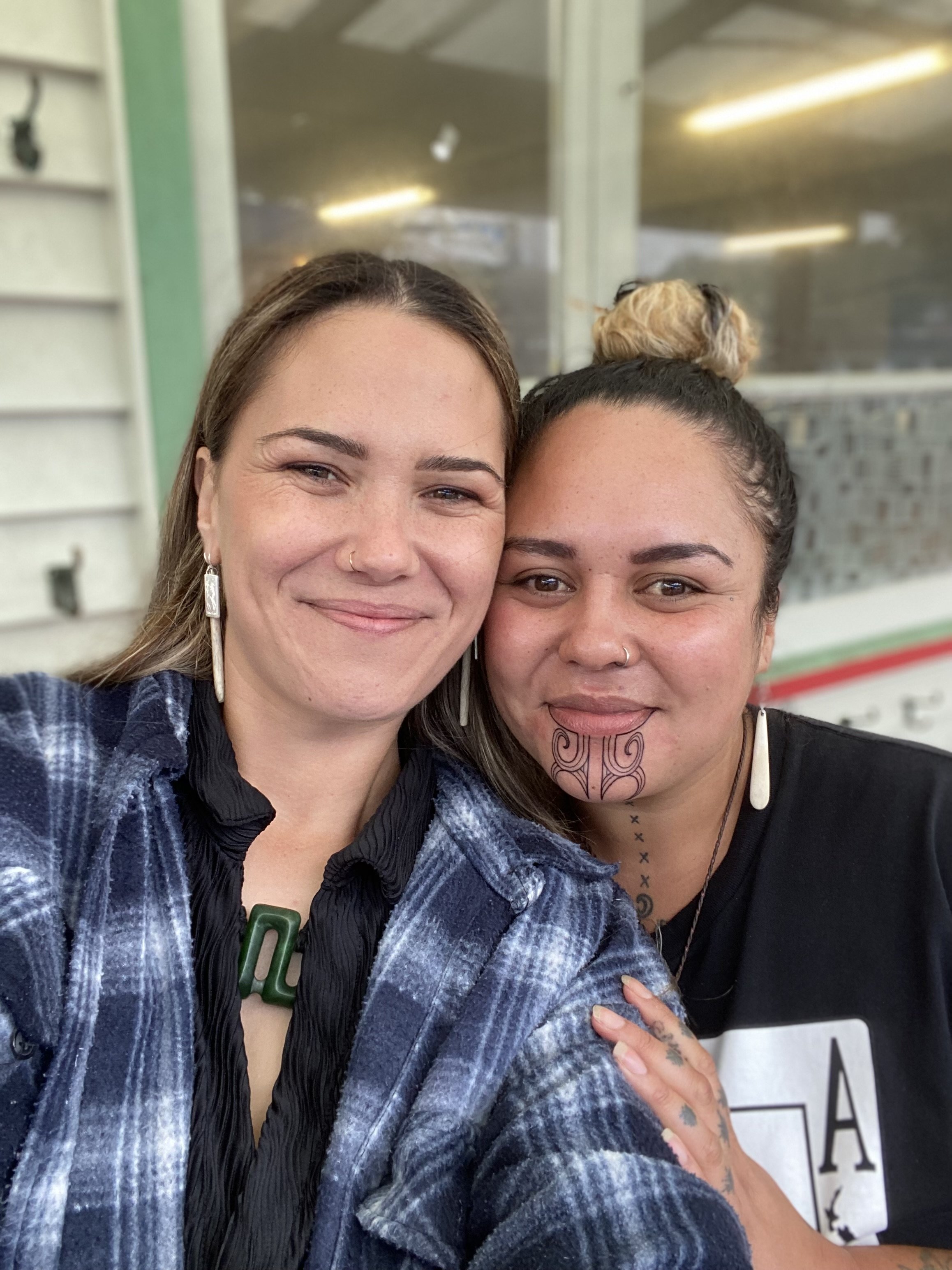
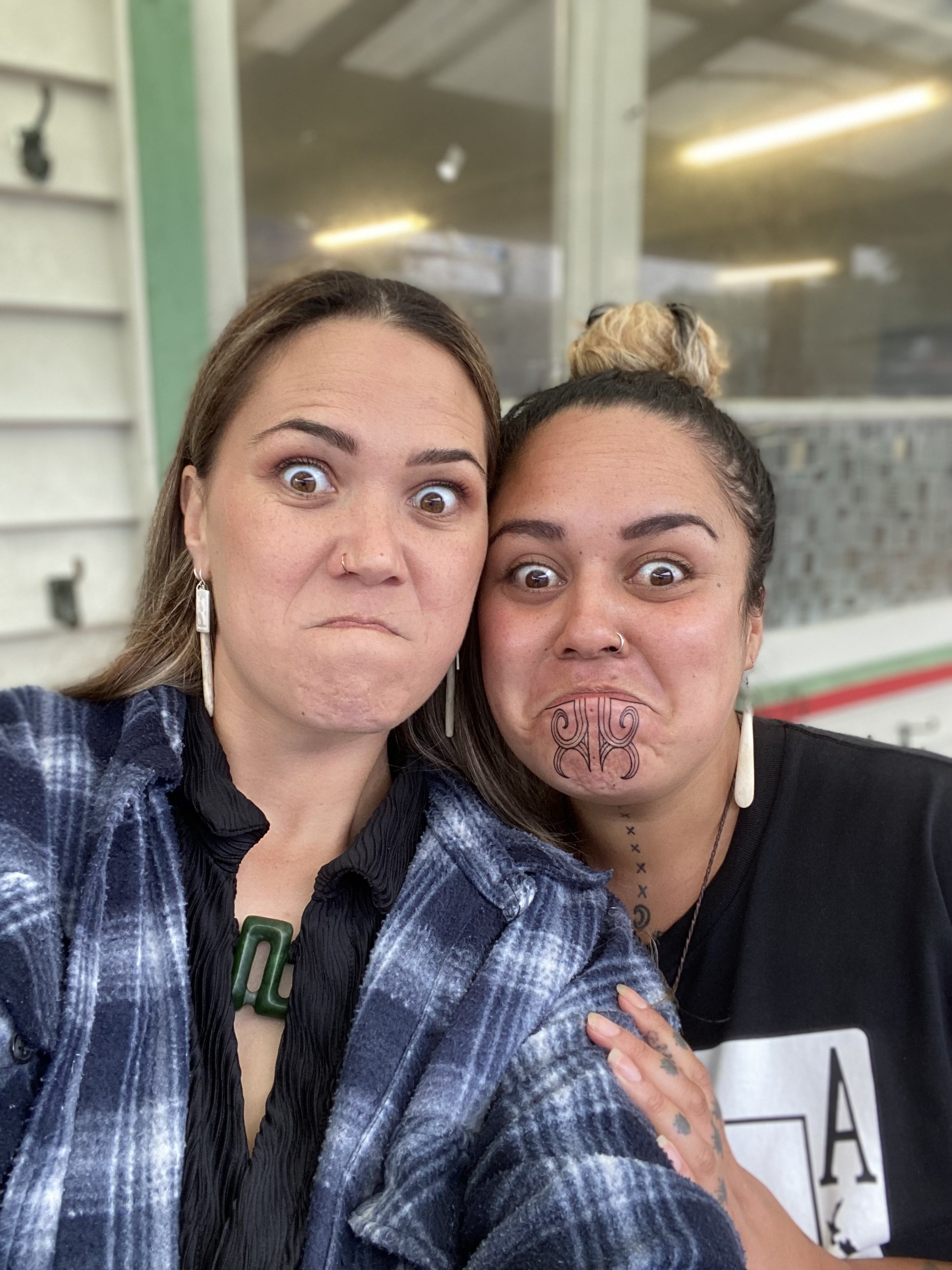

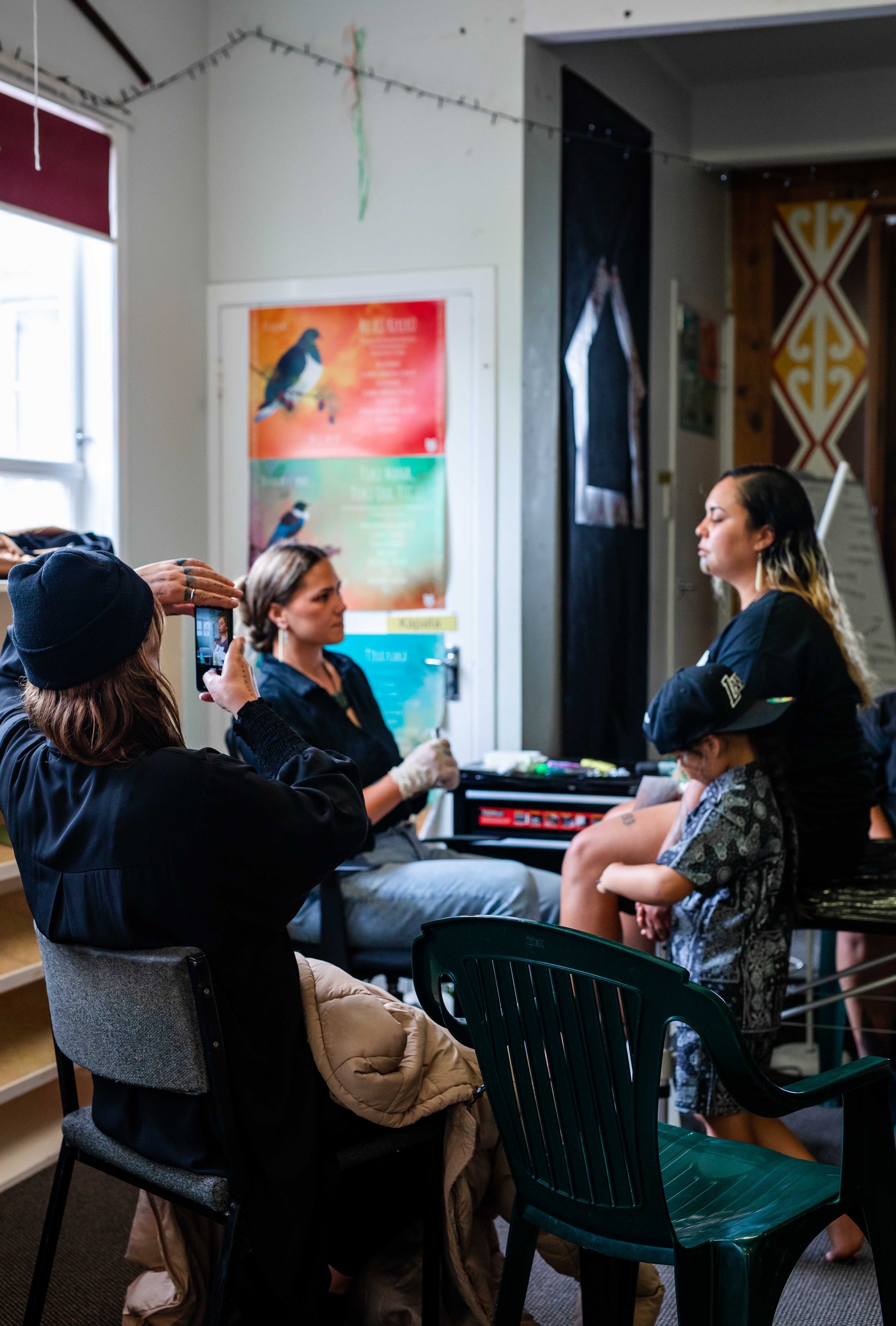



Te Whānau o Tahiti Akavi.